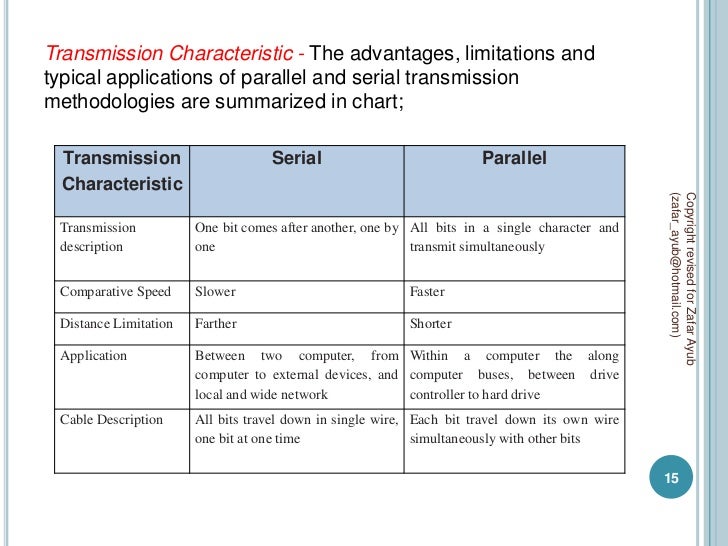Advantages And Disadvantages Of Serial And Parallel Data Transmission
What are the advantages and disadvantages of serial and parallel LCD? Update Cancel. Read Forrester Wave™ MDM report. Get Forrester's perspective on the top 12 master data management providers against 31 criteria. What are the advantages and disadvantages of using Ryobi tools?
Data Communication & Computer Networks: Serial and parellel transmission • 1. Introduction to Data communication Topic: Serial & Parallel Transmission Lecture #4 Dr Rajiv Srivastava Director Sagar Institute of Research & Technology (SIRT) Sagar Group of Institutions, Bhopal • Unit 1 Lecture 4 • Serial Transmission • In Serial Transmission, the bits of a byte are serially transmitted one after other. Candle time indicator. • The shift register is used for serial transmission. • The byte to be transmitted is the first stored in a shift register. • Then these bits are shifted from MSB to LSB bit by bit in synchronization with the clock.
Bits are shifted right by one by one position per clock cycle. • As an advantage only one wire is used in serial transmission between the transmitter and the receiver. 3 • 4 Serial Transmission • Some examples of serial Communication Devices • Morse code telegraphy • RS-232 (low-speed, implemented by serial ports) • RS-422 • RS-423 • RS-485 • Ethernet • SONET and SDH • T-1, E-1 Lines • Advantages of serial transmission • Only one wire is required • Reduction in cost due to less number of conductor wires • It is the most used method for long distance data transfers. Disadvantages of serial transmission • Since there is only one line of transmission therefore the speed of transmission is quite slow. • If we have to increase the speed of data transfer then it is necessary to increase the clock frequency.
But there is a limit of clock frequency. 6 • Serial transmission has two categories: 1. Synchronous data transmission 2. Asynchronous data transmission 7 Types of serial transmission? • Asynchronous Data Transmission • It is called asynchronous because timing of the signal is not an issue. The information can be sent & received as per mutual agreement of the sender & receiver.
• asynchronous transmission is at byte level only because transmission of bits is always synchronized. 8 0 Data Byte 1 Idle time 0 Data Byte 1 Idle 0 Start Stop • • Asynchronous transmission is eased by two its, a ely start it as & stop it as. • We se d it to start the o u i atio & it to stop the tra s issio. • There can be a time delay between communication of two bytes. • Only one byte is sent at a time. After a gap of time next byte is transmitted.
Free download driver finder license key and password download. • The transmitter and receiver may function at different clock frequencies. • Asynchronous transmission is mostly used by asynchronous modems. • Operation Before signalling will work, the sender and receiver must agree on the signalling parameters: • Full or half-duplex operation • The number of bits per character • the order in which the bits are sent • The speed or bits per second of the line (often incorrectly referred to as the Baud rate). Some systems use automatic speed detection. • Whether to use or not use parity • Odd or even parity, if used • The number of stop bits sent must be chosen (the number sent must be at least what the receiver needs) • 11 Asynchronous Transmission • Why it is called Asynchronous? This mechanism is called as Asynchronous because at the byte level the sender and receiver do not have to be synchronized. However within each byte, the receiver should still be synchronized with the incoming bit stream.
